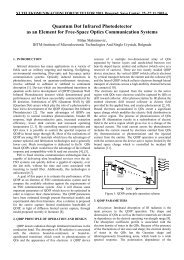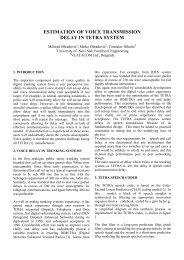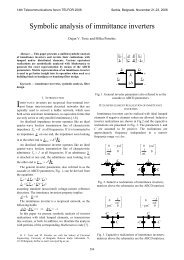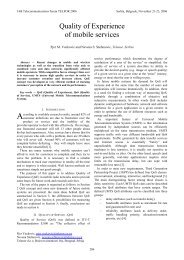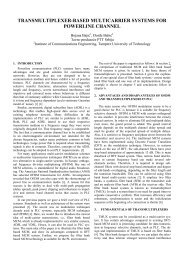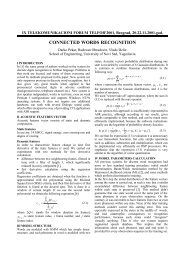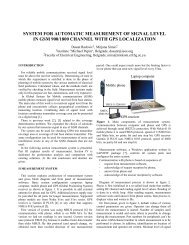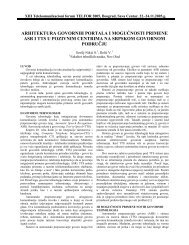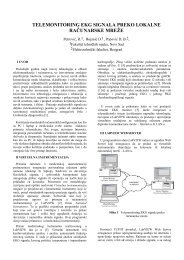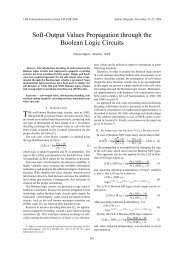Minimax LS Algorithm for Automatic Propagation Model Tuning - Telfor
Minimax LS Algorithm for Automatic Propagation Model Tuning - Telfor
Minimax LS Algorithm for Automatic Propagation Model Tuning - Telfor
- No tags were found...
Create successful ePaper yourself
Turn your PDF publications into a flip-book with our unique Google optimized e-Paper software.
<strong>Minimax</strong> <strong>LS</strong> <strong>Algorithm</strong> <strong>for</strong> <strong>Automatic</strong> <strong>Propagation</strong> <strong>Model</strong> <strong>Tuning</strong><br />
Simi} I.S. 1 , Stani} I. 1 , Zrni} B. 2<br />
1 Ericsson d.o.o , V. Popovi}a 6, Beograd<br />
2 Vojnotehni~ka Akademija, R. Resanovi}a 1, Beograd<br />
I INTODUCTION<br />
In mobile radio systems wave propagation models are<br />
necessary <strong>for</strong> a proper coverage planning, interference<br />
estimations, frequency assignment and cell parameter<br />
calculations, which are basic <strong>for</strong> network planning<br />
process. Number of prediction models has been<br />
developed so far. They are suitable <strong>for</strong> particular areas<br />
(urban, rural, open etc) and specific cell radius<br />
(macrocell, microcel, pikocell).<br />
The mobile subscriber’s terminal is free to travel and<br />
there<strong>for</strong>e the propagation path loss is directly related to<br />
the area in which mobile unit is passing. Various path<br />
loss characteristics that attribute mobile unit can be<br />
modelled with parameters in path loss prediction models.<br />
Because of complexity many of them are approximated<br />
or empirically estimated.<br />
In the path loss algorithms parameters can be adjusted<br />
<strong>for</strong> more than one kind of terrain contours and lend<br />
usage. In different areas these parameters are various<br />
and usually are subject <strong>for</strong> tuning. <strong>Propagation</strong> model<br />
tuning process are used to optimise the parameters in the<br />
propagation model and achieve minimal error between<br />
predicted and measured signal strength. This makes the<br />
model more accurate and signal strength predictions<br />
more reliable.<br />
Path-loss model parameters tuning process is highly time<br />
consuming and iterative. It requires change of one<br />
variable at the time in small steps and then does an<br />
analysis <strong>for</strong> each setting. There are several iterations to<br />
per<strong>for</strong>m, in order to find the smallest RMS error and<br />
standard deviations. In Ericsson’s software <strong>for</strong> path loss<br />
prediction and radio planning (EET / TEMS Cellplanner)<br />
automatics model-tuning method based on <strong>LS</strong> algorithm<br />
has been implemented [1]. <strong>Propagation</strong> prediction is<br />
based on modified Okumura [2] – Hata [3] model.<br />
In this paper we propose modification of the Least<br />
Square (<strong>LS</strong>) algorithm <strong>for</strong> automatics model tuning. We<br />
applied minimax modified iterative <strong>LS</strong> algorithm in tuning<br />
process and achieved better results.<br />
II PROPAGATION MODEL TUNING<br />
The objective of propagation model calibration is to<br />
obtain values <strong>for</strong> model parameters and land usage<br />
(clutter) codes such that they are in agreement with<br />
measured data. When using these calibrated parameters,<br />
the predicted signal level should have a minimum<br />
difference and variance when compared to measured<br />
signal level.<br />
Manual tuning process contain the following steps:<br />
1. RF field measurement;<br />
2. Analysis of a survey files (mean/RMS error,<br />
standard deviation);<br />
3. Adjustment of the parameters in order to set the<br />
mean errors to zero;<br />
4. Increment one parameter;<br />
5. Per<strong>for</strong>m a survey analysis and adjust other<br />
parameters so the mean error is zero;<br />
6. Repeat steps 2-5 until any change in parameters will<br />
increase RMS value.<br />
Manual tuning task requires a large number of repetitions<br />
be<strong>for</strong>e a near global minimum is obtained.<br />
An automatic model-tuning algorithm is in [1] originally<br />
proposed <strong>for</strong> Ericsson’s modification of Okumura – Hata<br />
model known as 9999 algorithm. It is, without knife-edge<br />
and spherical earth loss contribution, given by:<br />
*<br />
L = A + A log d + A log H<br />
0<br />
1<br />
+ A log d ⋅log<br />
H<br />
2<br />
[ H )] + g(<br />
f ) [ dB]<br />
−3.2 log(11.75<br />
where:<br />
*<br />
A A + µ<br />
2<br />
m<br />
eff<br />
0<br />
= 0 mob<br />
and<br />
mob<br />
3<br />
eff<br />
−<br />
(1)<br />
µ is value in [dB] of lend<br />
usage (clutter) type where mobile is located,<br />
d is distance from base station antenna to mobile [km],<br />
H eff is effective height of base station antenna [m],<br />
H m is height of mobile antenna [m] and<br />
g( f ) = 44.49log f − 4.78( log f ) 2<br />
where f is a frequency<br />
in MHz.<br />
A 0, A 1, A 2, A 3 are prediction steering parameters. In this<br />
case A 0<br />
*<br />
, A 1 are going to be optimised while A 2, A 3 are
assumed to be set to their default values, i.e. –12 and 0.1<br />
respectively. H m and f are known from the actual<br />
measurements. The tuning is then per<strong>for</strong>med <strong>for</strong> one<br />
clutter at a time.<br />
Measured path loss can be obtained in [dB] <strong>for</strong> each<br />
coordinate point by:<br />
M<br />
i<br />
EiRP + G<br />
A, i<br />
− SS<br />
measi ,<br />
= (2)<br />
where EiRP is emitted radiated power with cable losses<br />
and antenna gains [dBi] taken into consideration and G A,i<br />
is antenna masking gain <strong>for</strong> point i dependant on the<br />
horizontal and vertical angles between base and mobile<br />
station antennas. SS meas,i is measured signal strength <strong>for</strong><br />
coordinate point i. EiRP and G A,i are supposed to be<br />
known from the actual measurement process.<br />
For different clutter types, the sum of the difference<br />
between predicted values and measured data will be<br />
minimised and RMS error function will be as follows:<br />
N<br />
* 1<br />
*<br />
2<br />
E( A0 , k<br />
, A1,<br />
k<br />
) = ∑[<br />
Li<br />
( A0,<br />
k<br />
, A1,<br />
k<br />
) − M<br />
i<br />
] , (3)<br />
N<br />
i=<br />
1<br />
where N is number of measured points.<br />
Equation (1) can be written in <strong>for</strong>m<br />
*<br />
L i = A0 + A1<br />
Bi<br />
+ Ci<br />
(4)<br />
where<br />
B = log , (5)<br />
and<br />
i<br />
d i<br />
C = A logH<br />
i<br />
2<br />
eff , i<br />
2<br />
[ H )] + g(<br />
f ) ⋅<br />
−3.2 log(11.75<br />
+ A logd<br />
3<br />
m<br />
i<br />
⋅logH<br />
eff , i<br />
−<br />
(6)<br />
For minimising E(A 0 * , A 1 ), the equation (3) is<br />
differentiated partially with respect to A 0 * , A 1 . N<br />
equations have to be solved:<br />
i = 1:<br />
i = 2 :<br />
M<br />
i = N :<br />
*<br />
A + A log d<br />
M<br />
0<br />
*<br />
A + A log d<br />
0<br />
*<br />
A + A log d<br />
0<br />
1<br />
1<br />
1<br />
1<br />
2<br />
N<br />
+<br />
+<br />
C<br />
+ C<br />
C = M<br />
N<br />
1<br />
2<br />
= M<br />
M<br />
= M<br />
1<br />
2<br />
N<br />
. (7)<br />
The overdetermined eq. (7) system can be written as,<br />
⎡1<br />
⎢<br />
⎢<br />
1<br />
⎢M<br />
⎢<br />
⎣1<br />
B1<br />
⎤ ⎡ M<br />
1<br />
− C1<br />
⎤<br />
⎥ * ⎢ ⎥<br />
B2<br />
⎥<br />
⎡A<br />
⎤<br />
⎢<br />
M − C<br />
0<br />
2 2<br />
× ⎢ ⎥ = ⎥<br />
M ⎥ ⎣ A ⎦ ⎢ ⎥<br />
1<br />
M<br />
⎥ ⎢ ⎥<br />
BN<br />
⎦ ⎣M<br />
N<br />
− C<br />
N ⎦<br />
*<br />
The vector [ ] T<br />
<strong>LS</strong><br />
or<br />
a = A0<br />
A1<br />
can be obtained from<br />
T −1 T<br />
[ W W ] W Y<br />
W × a = Y . (8)<br />
a =<br />
. (9)<br />
III MINIMAX <strong>LS</strong> ALGORITHM<br />
Coefficients A 0 * , A 1 in expression (9) give minimal mean<br />
square difference (<strong>LS</strong> solution) between predicted pathloss<br />
value and measured path-loss data. In the most<br />
practical situations it is much better to have maximal<br />
error values smaller.<br />
There is number of minimax algorithms [4-7] that gives<br />
solution of minimal maximal error. The most suitable is<br />
minimax modified <strong>LS</strong> known as IR<strong>LS</strong> (Iterative<br />
Reweighted <strong>LS</strong>) algorithm [5]. The algorithm is based on<br />
an ides of modifying the Least Square method. IR<strong>LS</strong><br />
implements the windowing concept in <strong>LS</strong> algorithm, and<br />
shows that the concept can lead to minimax mismatching<br />
[5].<br />
IR<strong>LS</strong> algorithm in time domain is given by<br />
T<br />
−1<br />
T<br />
[ W R(<br />
j −1)<br />
W] W R(<br />
j −1<br />
Y<br />
a ( j)<br />
=<br />
(10)<br />
IR<strong>LS</strong><br />
)<br />
where j is iteration number and R(j-1) is a weighted<br />
(window) error matrix:<br />
and<br />
[ r(<br />
j 1) ]<br />
R ( j −1)<br />
= diag −<br />
(11)<br />
( j − ) ⋅e( j)<br />
r( j)<br />
= r 1 . (12)<br />
e is an error vector given by<br />
[ M − L , M − L , 2<br />
− ]<br />
e =<br />
1 1 2<br />
L,<br />
M N<br />
L N<br />
. (13)<br />
The weighted error which is included in the matrix R can<br />
be understood as a corrective factor of the <strong>LS</strong> algorithm.<br />
In every new iteration weights are innovated according<br />
errors from previous iteration.<br />
IV RESULTS<br />
To verify proposed algorithm <strong>for</strong> automatic model tuning<br />
RF field measurement carried out at many locations in<br />
Serbia. Active base stations (BS) in “Telekom Serbia”<br />
GSM mobile network are used as transmitters <strong>for</strong> signal<br />
strength measurement. For path-loss calculation real BS<br />
EiRP value is used while Heff and G A is calculated <strong>for</strong><br />
every measuremet point. Heff is calculated by relative<br />
method. Sampling speed is adjusted according vehicle<br />
speed (50 samples per sampling length of 40λ), in order<br />
to smooth out the Rayleigh fading and reduce the<br />
correlation between two adjacent samples [9]. Calibrated<br />
receiver from the TEMS Investigation tool per<strong>for</strong>ms<br />
measurement in the 0th time-slot at the BCCH<br />
frequency. RF measurement results are together with<br />
GPS coordinates stored in Signia files <strong>for</strong>mat and further<br />
processed in Matlab.
In the tuning process maps with 100m and 20m digital<br />
terain model (DTM) resolution have been used.<br />
Route I is measured in the region of city Indjija. For the<br />
open area estimated coefficients, standard deviation and<br />
maximal/RMS error is given in Table 1. It can be noted<br />
that maximal error is decreased while RMS error is<br />
increased. In the figure 1 and 2 change of maximal error<br />
and standard deviation in the itarative procedure is<br />
shown.<br />
A * 0 A 1<br />
STD RMS<br />
Error<br />
Max<br />
Error<br />
<strong>LS</strong> 45.95 100.6 6.04 36.5 20.2<br />
IR<strong>LS</strong> 47.31 101.0 6.04 38.0 18.4<br />
Table 1 Estimated coefficients <strong>for</strong> the open area.<br />
20.4<br />
[dB]<br />
20.2<br />
20<br />
19.8<br />
19.6<br />
19.4<br />
19.2<br />
19<br />
18.8<br />
18.6<br />
18.4<br />
0 5 10 15 20 25 30 35 40 45 50<br />
Iteration Number<br />
Fig. 1 Decrease of maximal errior in the iterative<br />
procedure.<br />
145<br />
[dB]<br />
140<br />
135<br />
130<br />
125<br />
120<br />
115<br />
110<br />
105<br />
iii<br />
100<br />
0 1000 2000 3000 4000 5000 6000 7000 8000 9000 10000<br />
Sample number<br />
Fig. 3 Comparison of mesured (i) and predicted path-loss<br />
with coeficients obtained by <strong>LS</strong> (ii) and IR<strong>LS</strong> (iii)<br />
algorithm.<br />
Figure 3 shows path-loss measured on the route 1<br />
compared with the path losses obtained by <strong>LS</strong> (dotted<br />
line) and IR<strong>LS</strong> algorithm (solid line).<br />
A * 0 A 1<br />
STD RMS<br />
Error<br />
i<br />
ii<br />
Max<br />
Error<br />
<strong>LS</strong> 43.20 68.93 4.96 24.52 17.36<br />
IR<strong>LS</strong> 44.17 80.55 4.96 27.1 14.56<br />
Table 2 Estimated coefficients <strong>for</strong> the suburban area.<br />
Route II is measured in the region of city Indjija but <strong>for</strong><br />
suburban area clutter. Estimated coefficients, standard<br />
deviation and maximal/RMS error is given in Table 2.<br />
Maximal error is decreased by 2.8 dB while RMS error is<br />
increased by 2.58 dB.<br />
[dB]<br />
6.12<br />
6.11<br />
IV CONCLUSION<br />
6.1<br />
6.09<br />
6.08<br />
6.07<br />
6.06<br />
6.05<br />
6.04<br />
0 5 10 15 20 25 30 35 40 45 50<br />
Iteration Number<br />
Fig. 2 Standard deviation during a iterative procedure.<br />
Not only RMS error and standard deviation are<br />
important parameters <strong>for</strong> evaluation of the propagation<br />
model tuning process. Maximal difference between<br />
predicted and measured values is significant and has to<br />
be minimised. In this paper algorithm <strong>for</strong> maximal error<br />
value minimisation based on minimax <strong>LS</strong> (IR<strong>LS</strong>)<br />
algorithm is proposed. It gives possibility to choice type<br />
of error that will be minimised in the tuning procedure.<br />
In some cases IR<strong>LS</strong> algorithm has a problem with<br />
convergence. It will be investigated in the future. Also,<br />
further research will be focused on automatic tuning <strong>for</strong><br />
all steering parameters defined in 9999 propagation<br />
prediction model.<br />
LITERATURE
[1] Ericsson Radio Systems AB, TEMS TM CellPlanner 3.4<br />
User Guide, 2001.<br />
[2] Y. Okumura, E. Ohmori, T. Kawano, K. Fukuda, ”Field<br />
strength and its variability in VHF and UHF land-mobile<br />
radio service”, Review of the ECL, 16, pp. 825-873,<br />
1968<br />
[3] Hata M., “Empirical <strong>for</strong>mula <strong>for</strong> propagation loss in land<br />
mobile radio service”, IEEE Trans. on Vehicular and<br />
Technology VT-29, pp. 317-325, 1980.<br />
[4] Haykin S.,”Adaptive Filter Theory”, Prentice Hall, New<br />
York, 1986.<br />
[5] Rapajic P. B., Zejak A. J., "Low sidelobe multilevel<br />
sequences by minimax filter", Electronics letters, Vol.<br />
25, No-16, pp. 1090-1091, 1989<br />
[6] Zejak A. J., Zentner E., Rapajic P. B. "Doppler optimized<br />
mismatched filters", Electronics letters, Vol 21, No. 7,<br />
pp. 558-560, 1991<br />
[7] Cavin R.K., at all,”The design of optimal convolution<br />
filters via linear programming”, IEEE Trans. Geosc.<br />
Electron., Vol. GE-7,No.3, pp.142-145,1969<br />
[8] Digital mobile radio towards future generation systems,<br />
COST 231 group Final Report, COST Telecom<br />
Secretariat, COST@postman.dg13.cec.be<br />
[9] Lee, W. “Mobile Communication Engineering - Theory<br />
and Applications”, McGraw-Hill, 1998<br />
Abstract: <strong>Propagation</strong> model tuning is time consuming<br />
and iterative process. <strong>Automatic</strong> model tuning based on<br />
<strong>LS</strong> algorithm is proposed in Ericsson’s TEMS<br />
Cellplanner radio planning tool. In this paper we suggest<br />
use of modified <strong>LS</strong> algorithm that decrease maximum<br />
error of predicted signal without influence on standard<br />
deviation compared to <strong>LS</strong> method.<br />
AUTOMATSKO PODE[AVANJE PARAMETARA<br />
PROPAGACIONOG MODELA PRIMENOM<br />
MINIMAKSNOG <strong>LS</strong> ALGORITMA<br />
Simi} I., Stani} I., Zrni} B.



